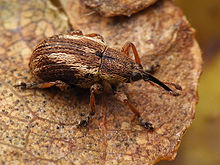Species of beetle
| Exapion fuscirostre |
 |
Scientific classification  |
| Domain: | Eukaryota |
| Kingdom: | Animalia |
| Phylum: | Arthropoda |
| Class: | Insecta |
| Order: | Coleoptera |
| Infraorder: | Cucujiformia |
| Family: | Brentidae |
| Genus: | Exapion |
| Species: | E. fuscirostre |
| Binomial name |
Exapion fuscirostre
(Fabricius, 1775) |
| Synonyms |
| |
Exapion fuscirostre (formerly Apion fuscirostre) is a species of straight-snouted weevil known by the general common name Scotch broom seed weevil. It is used as an agent of biological pest control against the noxious weed known as Scotch broom (Cytisus scoparius).
The adult weevil is dark gray with a dark band across its elytra and is a laterally compressed shape with a long snout and light brown legs. It is 2–3 millimetres (0.079–0.118 in) long. The adult feeds on new growth at the tips of stems, but the larva does much more damage to the plant. The adult female lays eggs inside the plant's seed pod, where the larvae hatch and consume the seeds over a period of a few weeks.
This weevil is native to Europe. It has been released in the western United States, where it has shown promise as a biocontrol agent for Scotch broom. It is now widespread in the Pacific Northwest.
There is a parasitic wasp, Pteromalus sequester, that uses the weevil as a host. This could possibly hinder efforts to keep the weevil established, but further study is needed.
References
- Coombs, E. M., et al., Eds. (2004). Biological Control of Invasive Plants in the United States. Corvallis: Oregon State University Press, 164.
External links
Extant Coleoptera families
|
|
|---|
- Crowsoniellidae (Crowsoniella relicta)
- Cupedidae (reticulated beetles)
- Jurodidae (Sikhotealinia zhiltzovae)
- Micromalthidae (telephone-pole beetle)
- Ommatidae
|
|
|
|---|
| Extant families | - Amphizoidae (trout-stream beetles)
- Aspidytidae
- Carabidae (ground beetles)
- Cicindelidae (tiger beetles)
- Dytiscidae (predaceous diving beetles)
- Gyrinidae (whirligig beetles)
- Haliplidae (crawling water beetles)
- Hygrobiidae
- Meruidae (Meru phyllisae)
- Noteridae (burrowing water beetles)
- Trachypachidae (false ground beetles)
|
|---|
|
|
|
|
|---|
| Bostrichiformia | | Bostrichoidea | - Bostrichidae (auger beetles)
- Dermestidae (skin beetles)
- Endecatomidae
- Jacobsoniidae (Jacobson's beetles)
- Nosodendridae (wounded-tree beetles)
- Ptiniidae (furniture beetles, death watch beetles, spider beetles)
|
|---|
| Derodontoidea | - Derodontidae (tooth-necked fungus beetles)
|
|---|
|
|---|
| Cucujiformia | | Chrysomeloidea | |
|---|
| Cleroidea | |
|---|
| Coccinelloidea | |
|---|
| Cucujoidea | |
|---|
Curculionoidea
(weevils) | - Anthribidae (fungus weevils)
- Attelabidae (leaf-rolling weevils)
- Belidae (primitive weevils)
- Brentidae (straight snout weevils, New York weevil)
- Caridae
- Curculionidae (true weevils, bark beetles, ambrosia beetles)
- Nemonychidae (pine flower weevils)
|
|---|
| Lymexyloidea | - Lymexylidae (ship-timber beetles)
|
|---|
| Tenebrionoidea | - Aderidae (ant-like leaf beetles)
- Anthicidae (ant-like flower beetles)
- Archeocrypticidae (cryptic fungus beetles)
- Boridae (conifer bark beetles)
- Chalcodryidae
- Ciidae (minute tree-fungus beetles)
- Melandryidae (false darkling beetles)
- Meloidae (blister beetles)
- Mordellidae (tumbling flower beetles)
- Mycetophagidae (hairy fungus beetles)
- Mycteridae (palm and flower beetles)
- Oedemeridae (false blister beetle)
- Perimylopidae, or Promecheilidae
- Prostomidae (jugular-horned beetles)
- Pterogeniidae
- Pyrochroidae (fire-coloured beetles)
- Pythidae (dead log bark beetles)
- Ripiphoridae (wedge-shaped beetles)
- Salpingidae (narrow-waisted bark beetles)
- Scraptiidae (false flower beetles)
- Stenotrachelidae (false longhorn beetles)
- Synchroidae (synchroa bark beetles)
- Tenebrionidae (darkling beetles)
- Tetratomidae (polypore fungus beetles)
- Trictenotomidae
- Ulodidae
- Zopheridae (ironclad beetles, cylindrical bark beetles)
|
|---|
|
|---|
| Elateriformia | | Buprestoidea | - Buprestidae (jewel beetles, or metallic wood-boring beetles)
- Schizopodidae
|
|---|
| Byrrhoidea | - Byrrhidae (pill beetles)
- Callirhipidae (cedar beetles)
- Chelonariidae (turtle beetles)
- Cneoglossidae
- Dryopidae (long-toed water beetles)
- Elmidae (riffle beetles)
- Eulichadidae (forest stream beetles)
- Heteroceridae (variegated mud-loving beetles)
- Limnichidae (minute mud beetles)
- Lutrochidae (travertine beetles)
- Psephenidae (water-penny beetles)
- Ptilodactylidae
|
|---|
| Dascilloidea | - Dascillidae (soft bodied plant beetles)
- Rhipiceridae (cicada beetle, cicada parasite beetles)
|
|---|
| Elateroidea | - Artematopodidae (soft-bodied plant beetles)
- Brachypsectridae (Texas beetles)
- Cantharidae (soldier beetles)
- Cerophytidae (rare click beetles)
- Elateridae (click beetles)
- Eucnemidae (false click beetles)
- Jurasaidae
- Lampyridae (fireflies)
- Lycidae (net-winged beetles)
- Omethidae (false fireflies, long-lipped beetles)
- Phengodidae (glowworm beetles)
- Rhagophthalmidae
- Sinopyrophoridae
- Throscidae (false metallic wood-boring beetles)
|
|---|
| Rhinorhipoidea | - Rhinorhipidae (Rhinorhipus tamborinensis)
|
|---|
| Scirtoidea | |
|---|
|
|---|
| Scarabaeiformia | | Scarabaeoidea | - Belohinidae (Belohina inexpectata)
- Bolboceratidae
- Diphyllostomatidae (false stag beetles)
- Geotrupidae (dor beetles)
- Glaphyridae (bumble bee scarab beetles)
- Glaresidae (enigmatic scarab beetles)
- Hybosoridae (scavenger scarab beetles)
- Lucanidae (stag beetles)
- Ochodaeidae (sand-loving scarab beetles)
- Passalidae (betsy beetles)
- Pleocomidae (rain beetles)
- Scarabaeidae (scarabs)
- Trogidae (hide beetles)
|
|---|
|
|---|
| Staphyliniformia | |
|---|
|
|
|
Taxon identifiers |
|---|
| Exapion fuscirostre | |
|---|
| Curculio fuscirostre | |
|---|
 | This Brentidae-related article is a stub. You can help Wikipedia by expanding it. |













